Related Research Articles

Vindication Island is a small uninhabited island of the Candlemas Islands in the South Sandwich Islands. It is one of about a dozen islands that make up the South Sandwich island arc, a chain of volcanoes in the Southern Ocean that was discovered in 1775 by James Cook. The volcanism is caused by the subduction of the South American Plate beneath the Sandwich Plate.

Bywell Castle is situated in the village of Bywell overlooking the River Tyne, four miles east of Corbridge, Northumberland, England. It is a Grade I listed building and a Scheduled Ancient Monument.

Arnold School was an independent school in Blackpool, Lancashire, England, established on the Fylde coast in 1896 during the Victorian expansion of public boarding schools in England.
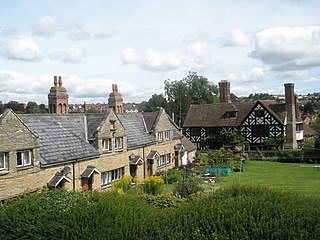
Ludford is a small village and civil parish in south Shropshire, England. The parish is situated adjacent to the market town of Ludlow and was, until 1895, partly in Herefordshire.
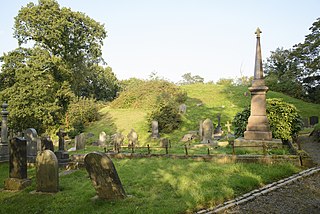
Penwortham Castle was built on the south bank of the River Ribble, at Penwortham to the west of Preston, Lancashire, England, at grid reference SD524291. The site is a Scheduled Ancient Monument, although only the mound remains.

Burton in Lonsdale Castle was in the village of Burton in Lonsdale in North Yorkshire, England.
Buttercrambe Castle was in the village of Buttercrambe in North Yorkshire, England.
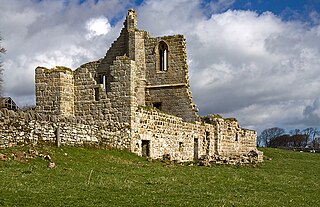
Cartington Castle is a ruinous, partly restored medieval English castle in the hamlet of Cartington, 2 miles (3.2 km) north-west of Rothbury in the county of Northumberland, England, looking down on the River Coquet. It is a Scheduled Ancient Monument and a Grade I listed building.
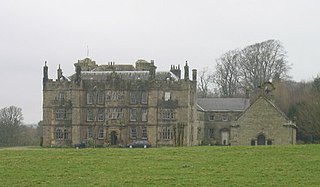
Chipchase Castle is a 17th-century Jacobean mansion incorporating a substantial 14th-century pele tower, which stands north of Hadrian's Wall, near Wark on Tyne, between Bellingham and Hexham in Northumberland, England. It is a Scheduled Ancient Monument and a Grade I listed building.

Cotherstone Castle was in the village of Cotherstone by the River Tees some 3 miles (5 km) north-east of Barnard Castle in County Durham, England.
Donington Castle was in the village of Castle Donington in Leicestershire, England to the north of East Midlands Airport.

Ford Castle is a Grade I listed building situated at a shallow crossing point on the River Till, Ford, Northumberland, England.

Hallaton Castle was situated to the west of the village of Hallaton, which lies some 20 km to the south-east of the city of Leicester. It seems likely that the castle formed the administrative centre of an estate owned by Geoffrey Alselin, which is described in the Domesday Book, pinpointing the construction of the castle happening before 1086 but after 1066.
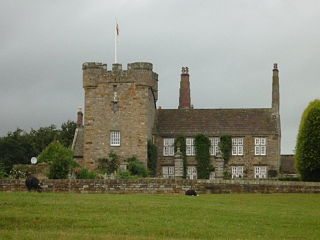
Halton Castle is a pele tower and grade I listed building situated close to Hadrian's Wall to the north of the village of Corbridge in Northumberland, England.

Kingerby Castle was in the small settlement of Kingerby some five miles north-west of Market Rasen, Lincolnshire.

Owston Ferry Castle was in the village of Owston Ferry in Lincolnshire, England.

Bouldon is a hamlet in Shropshire, England. It lies in the civil parish of Diddlebury.

Ascott d'Oyley is a village in Oxfordshire, England. The name ‘Ascott’ is derived from the Old English ēast (east) and cot (cottage), whilst d’Oyley was appended because Wido de Oileo ‘held the place in the late eleventh century.’ Ascott d’Oyley with its sister village Ascott Earl together form the larger community of Ascott-under-Wychwood. Ascott d’Oyley is recorded in the 1086 Domesday Book as having 14 households and a mill, under the lordship of Roger d'Oilly, and tenanted by Robert d’Oilly, whose family gives the village its name. An earthmound marks the remains of Ascott d’Oyley Castle. Today the village consists of stone-built houses and cottages grouped around the High Street and Mill Lane. Ascott d'Oyley is served by Windrush Valley School and Ascott-under-Wychwood railway station.
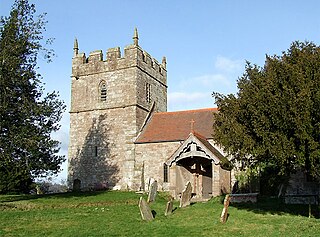
Holdgate is a small village and former civil parish, now in the parish of Abdon and Heath, in the Shropshire district, in the ceremonial county of Shropshire, England. Its name is taken from its Norman lord Helgot who owned the village in 1086 along with 17 other parishes in Shropshire. In 1931 the parish had a population of 47.

Holy Trinity Church is in the village of Holdgate, Shropshire, England. It is an active Anglican parish church in the deanery of Ludlow, the archdeaconry of Ludlow, and the diocese of Hereford. Its benefice is united with those of St Peter, Diddlebury, Broadstone Church, St Michael, Munslow, and St Catherine, Tugford. The church is recorded in the National Heritage List for England as a designated Grade I listed building. It stands in the former southwest bailey of Holdgate Castle.
References
- Fry, Plantagenet Somerset, The David & Charles Book of Castles, David & Charles, 1980. ISBN 0-7153-7976-3